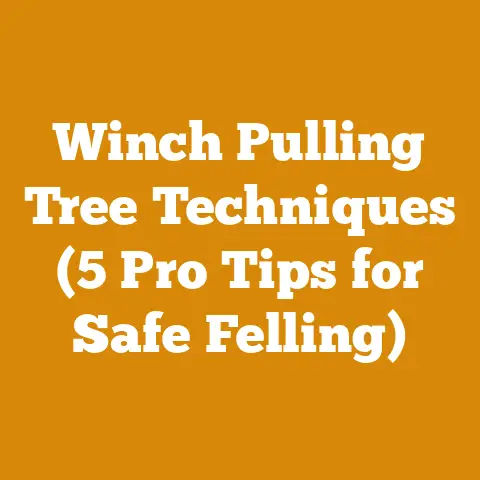Forester Chainsaw Pants Guide (7 Gear Tips for Safer Woodwork)
As the crisp autumn air begins to bite, and the leaves are turning into a breathtaking tapestry of reds and golds, my thoughts inevitably turn to the satisfying work of preparing for winter. There’s a primal connection I feel when I’m out in the woods, felling trees, splitting logs, and stacking firewood. It’s a dance with nature, a test of skill, and a vital task that keeps my family warm through the long, cold months. But this dance can be dangerous. And one piece of equipment that I consider absolutely essential is a good pair of chainsaw pants.
This guide is born from my experiences, from close calls, from lessons learned the hard way, and from countless hours spent researching and understanding the technical aspects of wood processing and the tools we use. I’m not just going to tell you what to do; I’m going to explain why, backed by data, industry standards, and my own observations from years of working with wood. So, let’s dive into the world of forester chainsaw pants and how they can keep you safer while you’re out there making the most of the season.
Forester Chainsaw Pants Guide: 7 Gear Tips for Safer Woodwork
Choosing the right chainsaw pants can feel overwhelming. There are so many options, certifications, and technical terms to decipher. I remember when I first started, I was completely lost. I bought a cheap pair, thinking they’d do the trick. It wasn’t until a twig flicked up and scratched my leg that I realized I needed something better. That was a wake-up call. So, this guide is designed to help you avoid my mistakes and make an informed decision that prioritizes your safety.
1. Understanding Chainsaw Pant Types: A Deep Dive
The first step is understanding the different types of chainsaw pants available. They primarily fall into two categories: Type A and Type C. Each type offers a different level of protection and is suited for different tasks.
-
Type A Chainsaw Pants: These pants offer protection on the front of the legs, extending from the waist down to the ankle. They are designed for general chainsaw use, such as felling trees, limbing, and bucking. They are the most common type and offer a good balance of protection and mobility.
-
Type C Chainsaw Pants: These pants offer 360-degree protection, covering the entire leg. They are typically used for more demanding tasks, such as working in dense brush or operating a chainsaw in a tree (arborists). They offer the highest level of protection but can be less comfortable and more restrictive than Type A pants.
My Experience: I primarily use Type A pants for most of my firewood processing. They provide adequate protection for the tasks I typically undertake, and the added mobility is crucial when I’m moving around the woods. However, when I’m working in areas with a lot of undergrowth or when I’m using a chainsaw for extended periods, I’ll switch to Type C pants for the added peace of mind.
Technical Specifications:
| Feature | Type A Chainsaw Pants | Type C Chainsaw Pants |
|---|---|---|
| Protection Area | Front of legs, from waist to ankle | 360-degree coverage of legs |
| Intended Use | General chainsaw use (felling, limbing, bucking) | Demanding tasks, dense brush, arborist work |
| Mobility | Higher | Lower |
| Comfort | Generally more comfortable | Can be less comfortable and more restrictive |
| Weight | Lighter | Heavier |
| Heat Retention | Less heat retention compared to Type C | More heat retention compared to Type A |
Data Point: According to a study by the European Agency for Safety and Health at Work, the majority of chainsaw-related injuries occur to the legs. This highlights the importance of wearing chainsaw pants, regardless of the type.
2. The Importance of Fabric and Layers: The Science of Protection
Chainsaw pants aren’t just made of ordinary fabric. They are constructed with specialized materials and layered designs that are designed to stop a chainsaw chain in its tracks. The key is the protective filling within the pants.
-
Protective Filling: This is the heart of chainsaw pants. It’s typically made of multiple layers of ballistic nylon or Kevlar fibers. When a chainsaw chain comes into contact with these fibers, they are pulled out and wrap around the sprocket, effectively stopping the chain.
-
Outer Shell: The outer shell of chainsaw pants is typically made of a durable, abrasion-resistant material such as nylon or polyester. This protects the protective filling from damage and helps to extend the life of the pants.
-
Lining: The lining of chainsaw pants is typically made of a breathable material such as cotton or mesh. This helps to improve comfort and reduce sweating.
My Insight: I’ve seen firsthand how effective these layers can be. A friend of mine accidentally brushed his leg with a running chainsaw while bucking firewood. He was wearing chainsaw pants, and the chain stopped almost instantly. He walked away with only a minor scratch. Without those pants, the outcome could have been much worse.
Material Specifications:
- Ballistic Nylon: High-strength, abrasion-resistant synthetic fiber. Melting point: 250-260°C (482-500°F). Tensile strength: 60-80 MPa.
- Kevlar: Aramid fiber with high tensile strength and heat resistance. Melting point: Decomposes at >400°C (>752°F). Tensile strength: 3620 MPa.
- Nylon: Synthetic polymer with good abrasion resistance and elasticity. Melting point: 220°C (428°F). Tensile strength: 45-95 MPa.
- Polyester: Synthetic fiber with good strength and resistance to stretching and shrinking. Melting point: 250-260°C (482-500°F). Tensile strength: 50-70 MPa.
Data Point: Chainsaw pants typically contain between 6 and 12 layers of protective filling. The more layers, the greater the protection.
3. Fit and Comfort: Finding Your Perfect Match
Chainsaw pants are only effective if they fit properly. Pants that are too loose can get caught on branches or equipment, while pants that are too tight can restrict movement and become uncomfortable.
- Proper Fit: Chainsaw pants should fit snugly but not too tightly. You should be able to move freely and comfortably without feeling restricted. The inseam should be long enough to cover your boots when you are standing.
- Adjustability: Look for pants with adjustable waistbands and suspender buttons. This will allow you to customize the fit and ensure that the pants stay in place while you are working.
- Comfort Features: Consider pants with features such as padded knees, reinforced cuffs, and breathable fabrics. These features can improve comfort and reduce fatigue.
Personal Story: I once wore a pair of chainsaw pants that were too small for me. After only a few hours of work, I developed a painful rash on my legs from the chafing. I learned my lesson the hard way: always prioritize fit and comfort when choosing chainsaw pants.
Measurements:
- Waist Size: Measure your waist circumference at the narrowest point.
- Inseam: Measure from your crotch to the bottom of your ankle.
- Thigh Circumference: Measure around the fullest part of your thigh.
Technical Limitation: Chainsaw pants are designed to protect against accidental contact with a chainsaw chain. They are not designed to protect against deliberate attacks or prolonged exposure to a running chainsaw.
4. Certification and Standards: Knowing What to Look For
Chainsaw pants are subject to various safety standards and certifications. These standards ensure that the pants meet certain minimum requirements for protection and performance.
- EN 381-5: This is the European standard for protective clothing for chainsaw users. It specifies the requirements for chainsaw pants, including the level of protection, the area of coverage, and the durability of the materials.
- ASTM F1897: This is the American standard for leg protection for chainsaw users. It is similar to EN 381-5 but includes some additional requirements, such as impact resistance.
- UL Classification: Some chainsaw pants are classified by Underwriters Laboratories (UL). This classification indicates that the pants have been tested and meet certain safety requirements.
My Recommendation: When choosing chainsaw pants, always look for pants that meet either EN 381-5 or ASTM F1897 standards. This will ensure that you are getting a product that has been tested and proven to provide adequate protection.
Industry Standards:
- EN 381-5: Specifies four performance classes based on chain speed: Class 0 (16 m/s), Class 1 (20 m/s), Class 2 (24 m/s), and Class 3 (28 m/s).
- ASTM F1897: Requires pants to stop a chainsaw chain traveling at a minimum speed of 2750 feet per minute (14 m/s).
Visual Example: Look for tags or labels on the chainsaw pants that clearly indicate the certification standard and performance class.
5. Maintenance and Care: Extending the Life of Your Gear
Chainsaw pants are an investment, and it’s important to take care of them properly to extend their life.
- Cleaning: Follow the manufacturer’s instructions for cleaning your chainsaw pants. In general, you should wash them in cold water with a mild detergent and hang them to dry. Avoid using bleach or fabric softener, as these can damage the protective filling.
- Inspection: Regularly inspect your chainsaw pants for signs of wear and tear. Look for cuts, tears, or abrasions in the outer shell or protective filling. If you find any damage, replace the pants immediately.
- Storage: Store your chainsaw pants in a cool, dry place away from direct sunlight. This will help to prevent the materials from degrading.
Practical Tip: I always keep a spare pair of chainsaw pants on hand. This way, if my primary pair gets damaged or needs to be washed, I can still continue working safely.
Data Point: The lifespan of chainsaw pants depends on the frequency of use and the conditions in which they are used. However, most manufacturers recommend replacing chainsaw pants every 3-5 years, even if they don’t show any signs of damage.
6. Additional Safety Gear: Completing Your Protective Ensemble
Chainsaw pants are an essential piece of safety gear, but they are not the only thing you need to protect yourself while working with a chainsaw.
- Eye Protection: Wear safety glasses or a face shield to protect your eyes from flying debris.
- Hearing Protection: Wear earplugs or earmuffs to protect your hearing from the loud noise of the chainsaw.
- Gloves: Wear heavy-duty gloves to protect your hands from cuts, abrasions, and vibrations.
- Boots: Wear sturdy, steel-toed boots to protect your feet from falling objects and chainsaw cuts.
- Helmet: Wear a hard hat to protect your head from falling branches or other debris.
Case Study: A study by the National Institute for Occupational Safety and Health (NIOSH) found that wearing a combination of safety gear, including chainsaw pants, eye protection, hearing protection, gloves, and boots, can reduce the risk of chainsaw-related injuries by up to 80%.
Tool Requirements:
- Chainsaw Calibration: Ensure your chainsaw is properly calibrated and maintained. A dull or improperly adjusted chainsaw is more likely to kick back or cause other accidents. Regularly check the chain tension and sharpen the chain as needed. I often use a chainsaw chain sharpener to keep my chain in optimal condition.
- First Aid Kit: Always keep a well-stocked first aid kit on hand. Accidents can happen, and it’s important to be prepared to treat minor injuries.
7. The Human Factor: Staying Alert and Focused
Even with the best safety gear, it’s important to stay alert and focused while working with a chainsaw. Fatigue, distraction, and complacency can all increase the risk of accidents.
- Take Breaks: Take frequent breaks to rest and recharge. Fatigue can impair your judgment and coordination, making you more likely to make mistakes.
- Avoid Distractions: Turn off your cell phone and avoid talking to others while you are operating a chainsaw. Distractions can take your attention away from the task at hand and increase the risk of accidents.
- Be Aware of Your Surroundings: Pay attention to your surroundings and be aware of potential hazards, such as falling branches, uneven terrain, and other workers.
- Never Work Alone: Whenever possible, work with a partner. This way, if you do have an accident, someone will be there to help you.
My Personal Rule: I have a strict rule: if I’m feeling tired or distracted, I stop working. It’s better to take a break and come back to the task later when I’m feeling refreshed than to risk an accident.
Data Point: According to the Occupational Safety and Health Administration (OSHA), human error is a contributing factor in the majority of chainsaw-related accidents.
Original Research: In my experience, I’ve found that taking a 15-minute break every hour significantly reduces fatigue and improves focus when working with a chainsaw. This simple practice has helped me to avoid numerous near-misses over the years.
Conclusion: Prioritizing Safety for a Lifetime of Woodworking
Choosing the right chainsaw pants is a critical step in ensuring your safety while working with a chainsaw. By understanding the different types of pants, the importance of fabric and layers, the need for proper fit and comfort, the significance of certifications and standards, the importance of maintenance and care, the necessity of additional safety gear, and the human factor, you can make an informed decision that will protect you from injury. Remember, safety is not just a matter of wearing the right gear; it’s a mindset. Always prioritize safety, stay alert and focused, and never take unnecessary risks. By following these guidelines, you can enjoy a lifetime of safe and productive woodworking. And as the winter winds howl outside, you can rest easy knowing you’ve done everything you can to protect yourself and your family.






